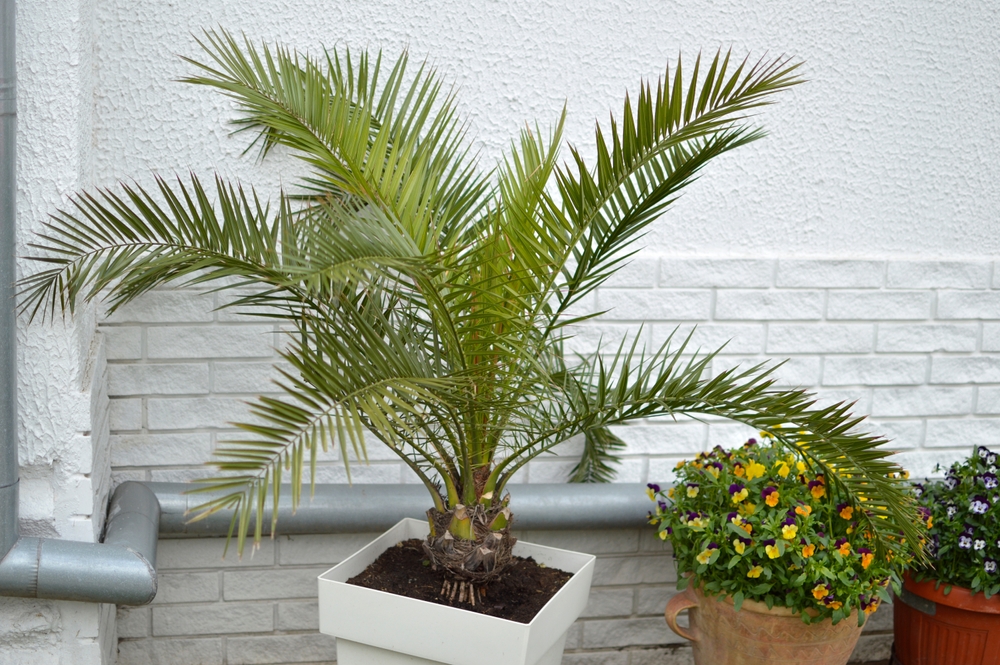Regal, stunning, and elegant, the majesty palm is one of the most beautiful tropical trees around. With its long fronds and statuesque trunk, this plant native to Africa can grow up to 100 feet tall in its natural habitat.
When grown indoors, plant parents can keep its roots confined in its pot, which limits its growth to about 6-10 feet. But even with its limited indoor growth, we can’t change the fact that this palm can significantly impact any space.
And its regal name is quite fitting since they’re finicky and pretty tricky to grow as a houseplant. Experts even say that majesty palms are one of the most challenging houseplants to care for.
But with the right environment and attention, your majesty palm can thrive and be a beautiful addition to your home. Here’s everything you need to know about majesty palm care.

| Botanical Name | Ravenea Rivularis |
| Common Name | Majestic Palm, Majesty Palm |
| Plant Type | Perennial |
| Flower Color | Tiny white flowers |
| Size When Mature | 120 to 1,200 inches (10-100 feet) tall |
| Bloom Time | Spring |
| Sun Requirements | Partial Sun |
| USDA Hardiness Zones | 10 – 11 |
| Soil PH Range | 5.0 – 6.0 |
| Soil Type | Acidic, Loam, Well-Draining |
| Water Needs | Medium |
| Native Area | Madagascar, Africa |
What You Need to Know About Majesty Palm
The Majesty palm is similar to a areca-palm. It’s well-loved for its arching green fronds, its physical characteristics also somewhat resemble the kentia plant. The majesty palm is truly a regal plant worthy of its name. Its tall, slender trunk is topped with a crown of long fronds that sway gracefully in the breeze. The leaves are a deep green, with a glossy sheen that catches the light.
However, it is often referred to as a temperamental houseplant since it’s quite tricky to take care of. They’re finicky and pretty particular about their environment and require a good balance of everything: fertilizer, light, and heat.
How to Care for Majesty Palm
Here’s everything you need to know about growing and caring for a thriving Majesty Palm:
Light
In its natural habitat, the majesty palm grows under the canopy of taller trees. This means they don’t mind some bright light, given that it hits them indirectly.
Indoors, it’s always recommended that you provide your majesty palm as much light as you possibly can. Lack of sunlight results in leggy and bleached leaves. However, take note too much sunlight can burn their leaves, so find a happy medium. The best place to put your majesty palm is near an east or west-facing window.
Water and Soil Needs
The Majesty palm is native to humid tropical environments like Madagascar, so it does best in soil that can mimic these conditions. Look for a potting mix that’s acidic, loamy, and well-draining. You can also amend your regular potting mix with pine bark fines or the typical peat moss to help increase the acidity levels.
A moderate amount of water is key to keeping your majesty palm happy. As always, prevent waterlogging, but avoid keeping its soil dry for prolonged periods. A pH level between 5.0 to 6.0 is ideal for the majesty palm.
Temperature Requirements
This plant loves humidity and grows well in temperature ranges between 65°F to 85°F. Usually, these conditions are met in USDA zones 10-11, making them a great outdoor plant for folks living in these areas.
For indoor growers, your best bet is to provide a humidifier or pebble tray to help increase the moisture in the air. These will help your majesty palm thrive and prevent brown tips from appearing on its leaves.
Unfortunately, it’s quite sensitive to sudden temperature changes and drafts. Humidity levels that are too low can cause the leaves to turn brown and crispy. Sudden changes in temperature, whether it’s too hot or too cold, can also shock your majesty palm and cause leaf drop.
Fertilizer
The best fertilizer to use on a Majesty Palm is a succulent cactus fertilizer that’s high in nitrogen and low in phosphorus. Any well-balanced fertilizer will do. Just remember to dilute the concentration in half.
Weak liquid fertilizer should be applied at least once during its growing season while preventing root burn by flushing the fertilizer out of its potting mix every few months.
Put a halt to your feeding schedule during the winter months, as your majesty palm will be in its dormant state.
Common Diseases
Root rot is one of the common killer diseases of majesty palms. It’s caused by overwatering, and signs to watch out for include yellowing leaves and stunted growth, partnered with a foul smell coming from the potting mix.
Additionally, common pests like whiteflies, spider mites, and scales love to feast on majesty palms. Usually, the culprits are found on the underside of its leaves. You’ll know your majesty palm is infested when you see telltale signs like webbing and some brown spots. Low humidity levels increase the risk of your plant getting infested.
Prevent these by regularly cleaning your majesty palm’s leaves with a damp cloth and increasing the humidity in the air around it. If there are already pests on your majesty palm, you can use horticultural oils or other mild insecticides to get rid of them.
Majesty Palm Propagation
The Majesty Palm is a beautiful indoor palm tree. Unlike other plants that you can propagate through step cuttings, majesty palms grow exclusively from seeds. However, if your plant starts to overcrowd its pot, a viable option is to divide the offsets or the small palms that start to sprout from the base of your plant.
While removing your mother plant from its pot, carefully roll the plant out, with the container facing sideways. Never pull your majesty palm out of its pot vertically.
Start to identify the offshoots (pups) and gently pull them apart from the main plant. Massage the root ball of each pup to loosen the roots a bit and replant them in their own containers.
Give each offset its own pot that’s large enough to accommodate its growth. Place in the center of your pot, and fill in the gaps with fresh potting mix. Tamp down the mix gently, making sure there are no air pockets left.
Water your offsets well, and place them in an area with bright, indirect sunlight.

